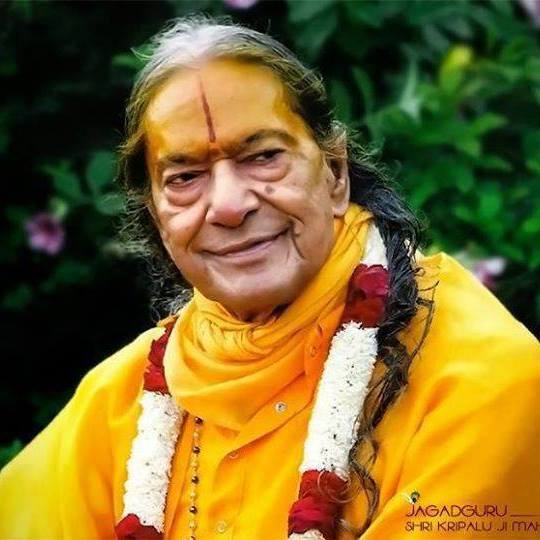At the beginning of November, I had the privilege of being in Gaya, India to take part in the historical event organized to commemorate the anniversary of our Guru, Shree Kripaluji Maharaj, and to offer my heartfelt tribute to Maharaj Ji and Amma Ji. Checking our travel details, there was only enough time to be there for the first day of sadhana. So, finding ourselves in a unique position of opportunity, my mother and I grabbed the next train from Delhi and sped off towards the west, towards Bihar. Gaya, according to the train schedule, is only sixteen hours away. However, with all the stops, delays, maintenance issues, and various other train problems, we ended up at the Gaya station four hours later. Such are the trials of travel anywhere in the world. But when we disembarked, we found ourselves surrounded by devotees from all over. Apparently, all of their trains were late, too–some by as much as seven hours. It didn’t matter–we were there, in Gaya, with a whole day to arrange accommodations, taxis and dinner before the beginning of sadhana next morning.
The venue was a pavilion near the center of Gaya, on a large green called Gandhi Maidan. Set up were a series of tents and marquees, on some of India’s lushest countryside. We began with arti and satsang at 4:30 am, going till 6:30, when breakfast was served. That first morning was utterly packed, with some devotees having just arrived, some with only the barest hint of sleep. People were tottering around all over the place, some just walking to stay awake, some working to smooth out the registration and accommodation lines. It was quickly clear to me that most of the people here were from India–the foreign devotee population, while sizeable, was nothing compared to those Indians from Vrindavan, from Barsana, from Delhi, from all over the subcontinent.
After a rushed breakfast, three more hours of sadhana took place in the main hall. People were constantly streaming up and down the aisles, the stage, to take blessings and give some contributions. I have to say, I’ve never done chanting like this before. Normally, in the prayer hall at Radha Madhav Dham or Mangarh, Barsana and Vridnavan, the space is designed for you to feel the music, to resonate with chants, to be a praying center. But the way the chants rose and fell in the semi-cylindrical hall at Gandhi Maidan, it was a whole other scale. The sheer amount of people packed into the hall, each and every one of them breathing, chanting, meditating–it was as if a whole new soundscape was being created, a place out of time and space, a music within the music.
I wish I could have translated the speeches that some of the senior preachers gave, but all I have are the hastily-written notes my mother took from that morning. The immense significance of Gaya was discussed–of all the holy places in India, Gaya is the most auspicious place to perform shraadh of a relative. Shree Krishna, Shree Ram, and many others came to Gaya for the last rites of their fathers. Maharaj Ji, too, came for his father’s rites, and the priests at Gaya have kept a record showing that for generations. Maharajji’s entire male line has been coming to the confluence of the Ganga, Yamuna, and Falgu rivers for the shraadh ceremony. The fact that we, as devotee-children of Maharaj Ji, get to take part in the same historical event, is nothing less than enormous.
The first ceremony was the pind dan at the river Falgu, where Mother Sita cursed the water to hide itself beneath the sand, after Falgu would not speak as a witness for her performing rites for Shree Ram’s father, and Dashrath Ji coming out of the water to accept her offering (if you go to Falgu’s banks today and dig in the sand awhile, water comes out). All of Maharaj Ji’s daughters were there, as well as his eldest son, eldest grandson, and several preachers, to say nothing of the two hundred-plus devotees gathered under the tent, next to the tent, and all around the tent. This was the only ceremony I could attend in our time there, but it was a big one. Devotees lined up along the river to light diyas and send them with the current. Offerings were made to the river several times, and to the priests performing the rites. So much was donated that the dhoti of the devotee collecting it sagged with all the rupees he was carrying. For four hours we chanted soulful kirtans on the riverbank, before heading back to the pavilion at Gandhi Maidan for a quick dinner and–you guessed it–more sadhana till nighttime.
I can’t tell you what I learned about Bihar on this trip, because I saw very little of Gaya outside our hotel, Gandhi Maidan and the train station. I can’t tell you all the names of the people I met, or the places they were from. I don’t even remember all of the people who’d come from the U.S., from New York, from Radha Madhav Dham, people who travel to India so rarely but had felt the intense need and longing to come for this. But what I can tell you is that first day in Gaya was something so rare, I will be blessed if anything resembling it comes my way again. My feet in the water, my toes in the sand of the river Falgu, I couldn’t help but think, maybe he was standing right here, not so long ago.

